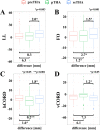Restoration of the hip geometry after two-stage exchange with intermediate resection arthroplasty for periprosthetic joint infection
- PMID: 33664369
- PMCID: PMC7933341
- DOI: 10.1038/s41598-021-84692-x
Restoration of the hip geometry after two-stage exchange with intermediate resection arthroplasty for periprosthetic joint infection
Abstract
Two-stage exchange with intermediate resection arthroplasty (RA) is a well-established surgical procedure in the treatment of chronic periprosthetic joint infection (PJI), whereby a higher failure rate of final hip geometry restoration due to tissue contraction is controversially discussed. The aim was to evaluate radiographic changes of hip geometry parameters during PJI treatment and to determine the impact of the intermediate RA on the final joint restoration after reimplantation of a total hip arthroplasty (reTHA). Radiographic parameters (leg length (LL), femoral offset (FO), horizontal/vertical acetabular center of rotation distance (h/vCORD)) of 47 patients (mean age: 64.1 years) were measured on standard radiographs of the pelvis and compared between four different stages during PJI treatment (pre-replacement status (preTHA), primary total hip arthroplasty (pTHA), RA and reTHA). The RA duration (mean: 10.9 months) and the number of reoperations during this period (mean: n = 2.0) as well as their impact on hip geometry restoration were evaluated. Between preTHA and pTHA/reTHA an equivalent restoration was measured regarding the FO (p < 0.001/p < 0.001) and hCORD (p = 0.016/p < 0.001), but not regarding the LL and vCORD. In contrast, analysis revealed no influence of RA and an equivalent reconstruction of LL (p = 0.003), FO (p < 0.001), v/hCORD (p = 0.039/p = 0.035) at reTHA compared to pTHA. Furthermore, RA duration (p = 0.053) and the number of reoperations after RA (p = 0.134) had no impact on radiographic hip geometry restoration. The two-stage exchange with intermediate RA does not alter the preexisting hip joint parameters, whereby a good restoration of the final hip geometry, independent of the duration or the number of reoperations, can be achieved.
Conflict of interest statement
The authors declare no competing interests.
Figures


Similar articles
-
The Influence of Spacer Design on the Rate of Complications in Two-Stage Revision Hip Arthroplasty.J Arthroplasty. 2019 Jun;34(6):1201-1206. doi: 10.1016/j.arth.2019.02.012. Epub 2019 Feb 15. J Arthroplasty. 2019. PMID: 30879874
-
Impact of Offset and Leg Length on Functional Outcomes Post-Total Hip Arthroplasty: How Accurate Should Coronal Reconstruction Be?J Arthroplasty. 2024 Sep;39(9S2):S332-S339.e2. doi: 10.1016/j.arth.2024.06.017. Epub 2024 Jun 18. J Arthroplasty. 2024. PMID: 38897260
-
Partial two-stage exchange for infected total hip arthroplasty: a preliminary report.Clin Orthop Relat Res. 2014 Feb;472(2):437-48. doi: 10.1007/s11999-013-3168-3. Clin Orthop Relat Res. 2014. PMID: 23852737 Free PMC article.
-
Megaprostheses in the Revision of Infected Total Hip Arthroplasty. Clinical Series and Literature Review.Bull Hosp Jt Dis (2013). 2015 Dec;73(4):229-32. Bull Hosp Jt Dis (2013). 2015. PMID: 26630464 Review.
-
Commercially manufactured spacers for the treatment of periprosthetic joint infection of the hip.Oper Orthop Traumatol. 2023 Jun;35(3-4):179-187. doi: 10.1007/s00064-023-00802-0. Epub 2023 Apr 11. Oper Orthop Traumatol. 2023. PMID: 37041387 Review. English.
Cited by
-
Periprosthetic hip infections caused by Brucella: a rare case report and literature review.J Int Med Res. 2024 Feb;52(2):3000605241234050. doi: 10.1177/03000605241234050. J Int Med Res. 2024. PMID: 38422032 Free PMC article. Review.
References
Publication types
MeSH terms
LinkOut - more resources
Full Text Sources
Other Literature Sources
Medical

